Roden's 1/144 scale
Douglas C-124A Globemaster II
by Roland Sachsenhofer
|
Douglas C-124A Globemaster II |

The challenge of depicting such a huge aircraft as the Globemaster II on such a small scale as 1:144 is particularly fascinating for me. But the question of whether one could credibly represent the really big in the really small was only one, albeit powerful, impulse to reach for this kit.
Another and of course no less important incentive came from the fascinating shape of this transport plane, a third from the exciting history in which the story of the Globemaster is embedded. These two points I would also like to mention at the very beginning of my report.
The importance of transport aircraft capacity for global armed forces was illustrated by the years of the Second World War. The sometimes unprecedented strategic situations brought about by the spread of the Cold War meant that the value of potentially expanded air transport continued to rise after 1945. The "Berlin Airlift" in 1948/49 ultimately became a symbol of the eminent value of a powerful and therefore sustainable air transport fleet.

Based on these insights and experiences, new concepts of large-capacity transport were explored in the late 1940s. The Douglas C-124 Globemaster II, first flown in 1949, was a particularly successful result of these efforts.
One example of the innovative spirit of those days was a hydraulically lowerable loading ramp at the bow and two heavy-duty cranes, each weighing 3800 kilograms, which could be used to load the side cargo doors. The C-124 was able to carry an impressive 31,100 kilograms of cargo to the maximum in the air; this required four Pratt & Wittney R-4360 engines, each producing 3800 hp.
Other characteristics also give an idea of what an impressive giant the Globemaster II must have been: over 53 metres of wingspan, with a length of 39.75 metres, the maximum weight of the machine is 88.2 tonnes.
In the years and decades that followed, the Globemaster II was used wherever the US armed forces had to land material on a large scale: the C-124 flew in the Korean War and ten years later in or after Vietnam. At these and other locations where the US military was operating, the C-124 made a significant contribution to the logistical link with the US homeland.
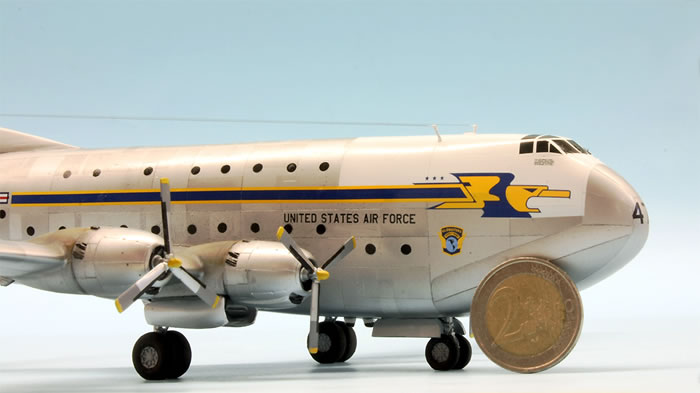
During the Cold War, however, the Globemaster fleet was also used for a specific task that initially only it was capable of: thanks to its dimensions, it could pick up and transport the Thor medium-range ballistic missile in one piece in its cargo hold.
From 1970 onwards, the remaining machines were passed on to the ANG, although the last C-124 Globemaster II was to be decommissioned as early as 1974. A total of 448 units were built and delivered to the US Air Force.
My specimen shows a C-124A of the 3rd Strategic Support Squadron, which with its striking color scheme may well be one of the most attractive Globemaster II. As a reference I was able to use the high quality footage of the 50's movie "Strategic Air Command", which offers first class footage for an interesting range of aircraft. The flight and ground shots of the B-36 Peacemaker or the B-47 Stratojet in this film are not without reason legend. I can warmly recommend this film to anyone who is enthusiastic about such aircraft!
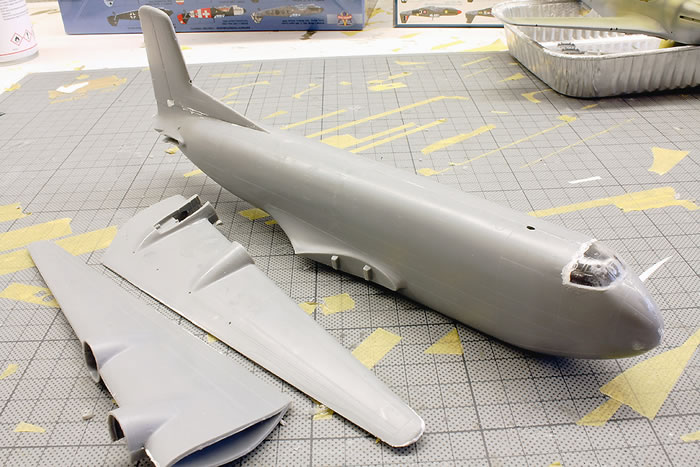
Another nice thing about it is that James Stewart is not only one of the most remarkable actor personalities of the US film, but also a former USAAF bomber pilot who knows what he is talking about.
But back to the model: the decals are from Caracal. I can recommend them for two reasons: on the one hand, they are easy to work with, are made with quality and offer the choice of after all eleven attractive versions of the Globemaster in US Air Force and ANG markings, on the other hand, this also solves the misery with the decals from Roden. I would like to put it in a short formula and not explain it further: the decals included in the kit are simply not usable.
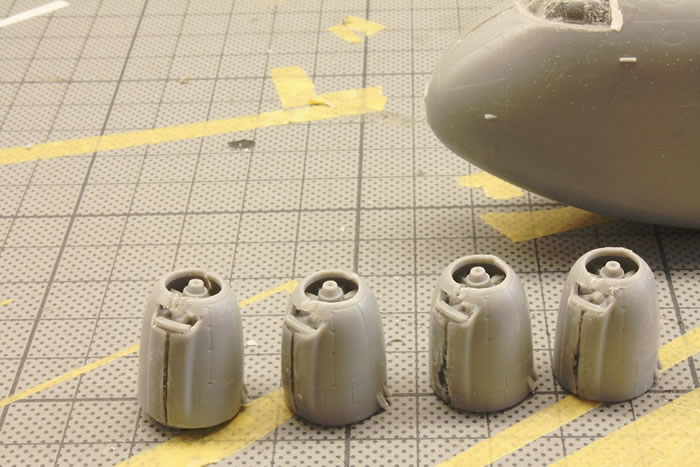
The verdict on the kit parts is milder. Accuracy of fit and formal coherence are good, necessary filling and sanding work is within the limits of what one can expect from a "short run" upscale kit.
A striking exception, however, is the engine nacelles, whose glued-together raw form has a gap of several millimetres in width that causes displeasure. But I don't want to exclude the possibility that the fault lies with me and that a more level-headed model builder would have managed a smooth collapse of the parts. But at least this part of the construction has to be called "tricky", it requires special care and in my case a lot of filler material.
The exterior of the model was completed with homemade antennas and wiring of the undercarriage; the main part of my detailing was done by the paint job, though.
I am proud of one small detail: the three windscreen wipers, each consisting of two parts, were scratched of etched parts - they are certainly the smallest thing that my tweezers have ever moved successfully!
Machines like the C-124 with its typical NMF-painting are a nice playground for trying out metal colours. As almost always in such a case, I resorted to the Alclad II range. In several work steps, alternating masking and spraying was used to imitate a metal skin as diverse as possible, close to the original.
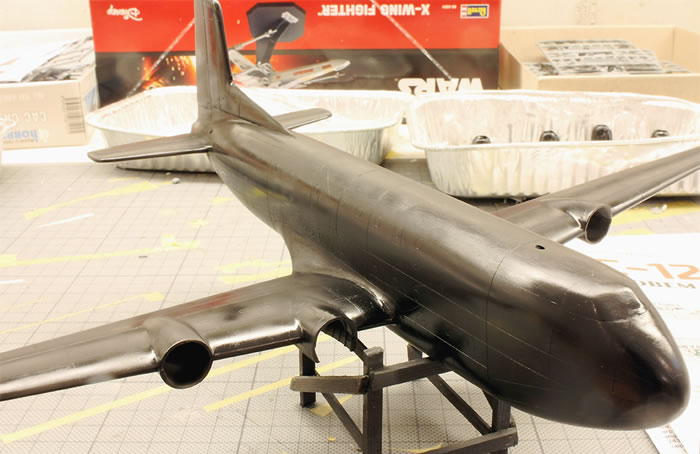
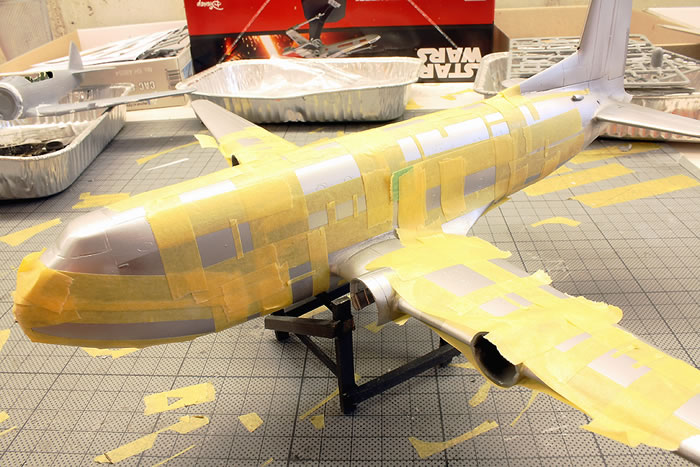
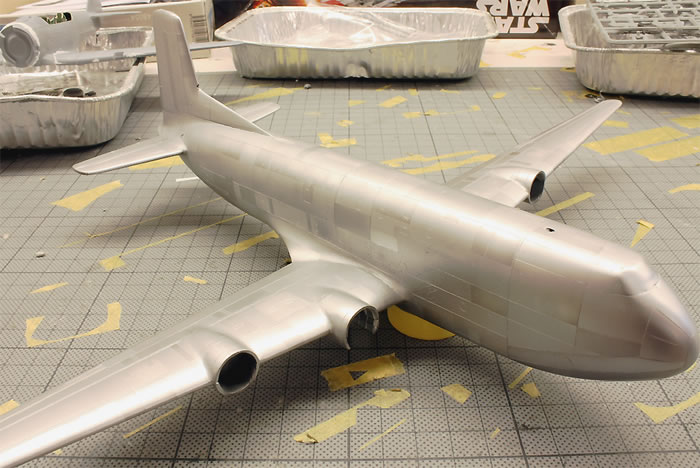

The orange of the "Dayglow" is from Gunze.
In conclusion I may say that I personally enjoyed this construction very much and consider the result as a certainly not "perfect" but for me successful approach to the varied appearance of a metal skin on a large surface.
Is it possible to credibly represent the really big in the really small? I do not know, but 1/144 scale will see me again!
If you are interested in the building process, please have a look here on Scalemates:
https://www.scalemates.com/profiles/mate.php?id=10148&p=albums&album=57484
As ever, remarks will be appreciated: ro.sachsenhofer@gmx.at
Model, Images and Text Copyright ©
2020 by Roland Sachsenhofer
Page Created 28 July, 2020
Last Updated
28 July, 2020
Back to HyperScale Main Page
|
Home
| What's New | Features | Gallery | Reviews | Reference | Resource Guides | Forum |